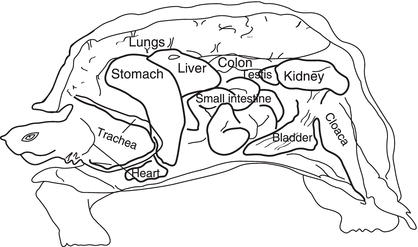Respiratory system
Figure 1.4.3 Anatomy: lateral section.

- Air enters the body through the external nares into the nasal cavity.
- The glottis is located on the floor of the mouth just behind the tongue.
- The glottis is positioned at the choana when the mouth is closed.
- The glottis has two arytenoid and one cricoid cartilages.
- The epiglottis is missing.
- The trachea has complete tracheal rings.
- Tracheal length varies among the species, but in some species it divides into primary bronchi cranially.
- The paired lungs are positioned dorsally against the carapace.
- The lungs are sac-like structures, partitioned into chambers.
- There is no diaphragm. The pleuroperitoneal membrane separating the lungs from the rest of the coelomic cavity is relatively thin and non-muscular.
- Muscle movements of the limbs and the pectoral and pelvic girdles create the negative pressure to draw air into the lungs.
- Chelonians are unable to cough effectively and clear secretions from the lower respiratory tract. This makes recovery from pneumonia more problematic.
Figure 1.4.3 Anatomy: lateral section.


